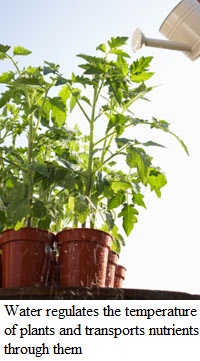|
|
|
|
 Plants
contain even more water than animals do -- most of them are anywhere
from 90 to 95 percent water. Just as it does in animals, water regulates
the temperature of the plant and transports nutrients through it. But
instead of taking in water by drinking and eating, plants get it through
dew, irrigation and rainfall. Plants
contain even more water than animals do -- most of them are anywhere
from 90 to 95 percent water. Just as it does in animals, water regulates
the temperature of the plant and transports nutrients through it. But
instead of taking in water by drinking and eating, plants get it through
dew, irrigation and rainfall.
Plants take in water through their roots, and green ones use it in
photosynthesis, which is how they create sugar for food. Plants also
need water to support themselves. Pressure from the process of osmosis
-- the movement of water from the outside to the inside of the plant's
cells -- keeps up the plant's cell walls.
When you water a plant, it sucks up the water through capillary action.
Then the water travels from the roots through tubes called xylem
vessels. Water reaches the leaves of the plant and escapes through small
holes called stomata, which open when the plant needs to cool down. This
process is called transpiration and is similar to how people (and some
animals) sweat. Carbon dioxide also enters the plant through the
stomata.
Processing water is more complicated in animals and people, although
it's also similar in a lot of ways. Water that you consume is absorbed
in the upper small intestine through osmosis. It enters the bloodstream
and is transported all over the body. Unlike plant cells, however,
animal cells do not have cell walls. This is why animals have
circulatory systems -- otherwise, our cells would absorb water and salt
until they swelled. Our circulatory systems move water around our bodies
and remove it as needed through sweating and urination.
A few animals, like a microscopic organism called the tart grade, can go
without water for an extraordinary period of time. If the tart grade's
environment doesn't have enough water, the animal goes into a life
without water, called anhydrobiosis. Sugar takes the place of water in
its cells, making it impervious to extremes in temperature. Its
metabolism lowers, and the tart grade stays at this barely alive state
until it has enough water to really live again.
Some plants have also found unique ways to live with little or no water.
One way is a variation of photosynthesis called Crassulacean Acid
Metabolism (CAM) photosynthesis. In CAM photosynthesis, a plant stores
carbon dioxide as acid and keeps its stomata closed during the day to
save water (evaporation happens at a slower rate at night). It can even
keep its stomata closed at all times if conditions are especially arid.
Cacti use CAM photosynthesis to survive the extreme heat and drought of
the desert.

Source: http://science.howstuffworks.com |
|


 Plants
contain even more water than animals do -- most of them are anywhere
from 90 to 95 percent water. Just as it does in animals, water regulates
the temperature of the plant and transports nutrients through it. But
instead of taking in water by drinking and eating, plants get it through
dew, irrigation and rainfall.
Plants
contain even more water than animals do -- most of them are anywhere
from 90 to 95 percent water. Just as it does in animals, water regulates
the temperature of the plant and transports nutrients through it. But
instead of taking in water by drinking and eating, plants get it through
dew, irrigation and rainfall.